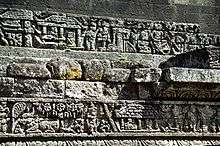Candi bentar
.jpg)
Candi bentar, or split gateway, is a classical Javanese gateway entrance commonly found at the entrance of religious compounds, kraton palaces, or cemeteries.[1] It is basically a candi-like structure split perfectly in two to create a passage in the center for people to walk through. A candi bentar is commonly found in Java, Bali, and Lombok.
Form
Candi bentar has a candi-like form but split perfectly in two to create a symmetrical image. Candi bentar characteristically has a stepped profile, which can be heavily decorated in the case of Balinese candi bentar. The two inner surfaces are always left sheer and unornamented, as if the structure has been split in two.[2]
Classical Javanese and Balinese Hindu temple
Candi bentar and paduraksa (another gateway structure) are integral features of a Balinese temple architecture, and possibly the classical Javanese Hindu temple. Both gateways mark the threshold between different level of sanctity within a temple compound. Candi bentar marks the boundary between the outer world with the outer realm of the Hindu temple, the nista mandala ("outer sanctum"). The paduraksa marks the boundary between the madya mandala ("middle sanctum") with the innermost and the most sacred utama mandala ("main sanctum").[3]
The symbolism of a candi bentar is unclear. Candi bentar probably only serve for aesthetic purpose, to create a sense of grandeur before entering a compound.
Origin and evolution

Candi bentar is thought to dates back to the Hindu period of Singhasari and Majapahit in 13th to 14th-century Java.[2] Reliefs showing a candi bentar and paduraksa have been discovered in 13th-century Candi Jago in East Java. In the archaeological site of Trowulan – the 14th-century capital of the Majapahit empire – a candi bentar named Gopura Wringin Lawang (Javanese "the Banyan Tree Gate"), is among the oldest candi bentar that still stands. The Gopura Wringin Lawang took the shape of a typical Majapahit temple structure evenly split into two mirroring structures, creating a passage in the center.

The candi bentar is still widely used upon the arrival of Islam period in the 15th-century. The Sultanate palace of The Keraton Kasepuhan used candi bentar to mark access into the public audience pavilion. The 16th-century Menara Kudus Mosque, one of the oldest mosque in Java, still has a candi bentar in its compound, marking the gateway into the mosque compound. A Muslim cemetery complex of Sendang Duwur in the village of Sendang Duwur, Lamongan Regency, East Java, contains both candi bentar and paduraksa to marks the level of sanctity within the cemetery complex, with the tomb of Sunan Sendang Duwur being the most sacred part of the cemetery complex.[4] Other Javanese tombs employing the candi bentar is the Sunan Giri cemetery complex.

In modern period, construction of candi bentar is encouraged by the Indonesian government. The government of Old Banten encouraged the construction of candi bentar in the entrance gate of every houses, especially those located along the main road.[5] In the city of Cirebon, West Java, the red brick candi bentar has become the identity of the city. Candi bentar also mark the entrance gateway toward various civic buildings e.g. the Soekarno-Hatta International Airport in Jakarta.
See also
| Wikimedia Commons has media related to Candi bentar. |
References
- ↑ Wardani, Sitindjak & Mayang Sari 2015, p. 2.
- 1 2 Davison 2003, p. 36.
- ↑ Wardani, Sitindjak & Mayang Sari 2015, p. 3.
- ↑ Wardani, Sitindjak & Mayang Sari 2015, p. 9.
- ↑ Uka Tjandrasasmita 2009, p. 247.
Cited works
- Davison, Julian (2003). Balinese architecture. Singapore: Tuttle Publishing. ISBN 9780794600716.
- Uka Tjandrasasmita (2009). Arkeologi Islam Nusantara [Nusantara Islamic Archeology]. Jakarta: Kepustakaan Populer Gramedia. ISBN 9789799102126.
- Wardani, Laksmi Kusuma; Sitindjak, Ronald Hasudungan Irianto; Mayang Sari, Sriti (2015). "Estetika Ragam Hias Candi Bentar dan Paduraksa di Jawa Timur" [Ornament aesthetic of Candi Bentar and Paduraksa in East Java] (PDF) (in Indonesian). Petra Christian University. Retrieved November 19, 2016.